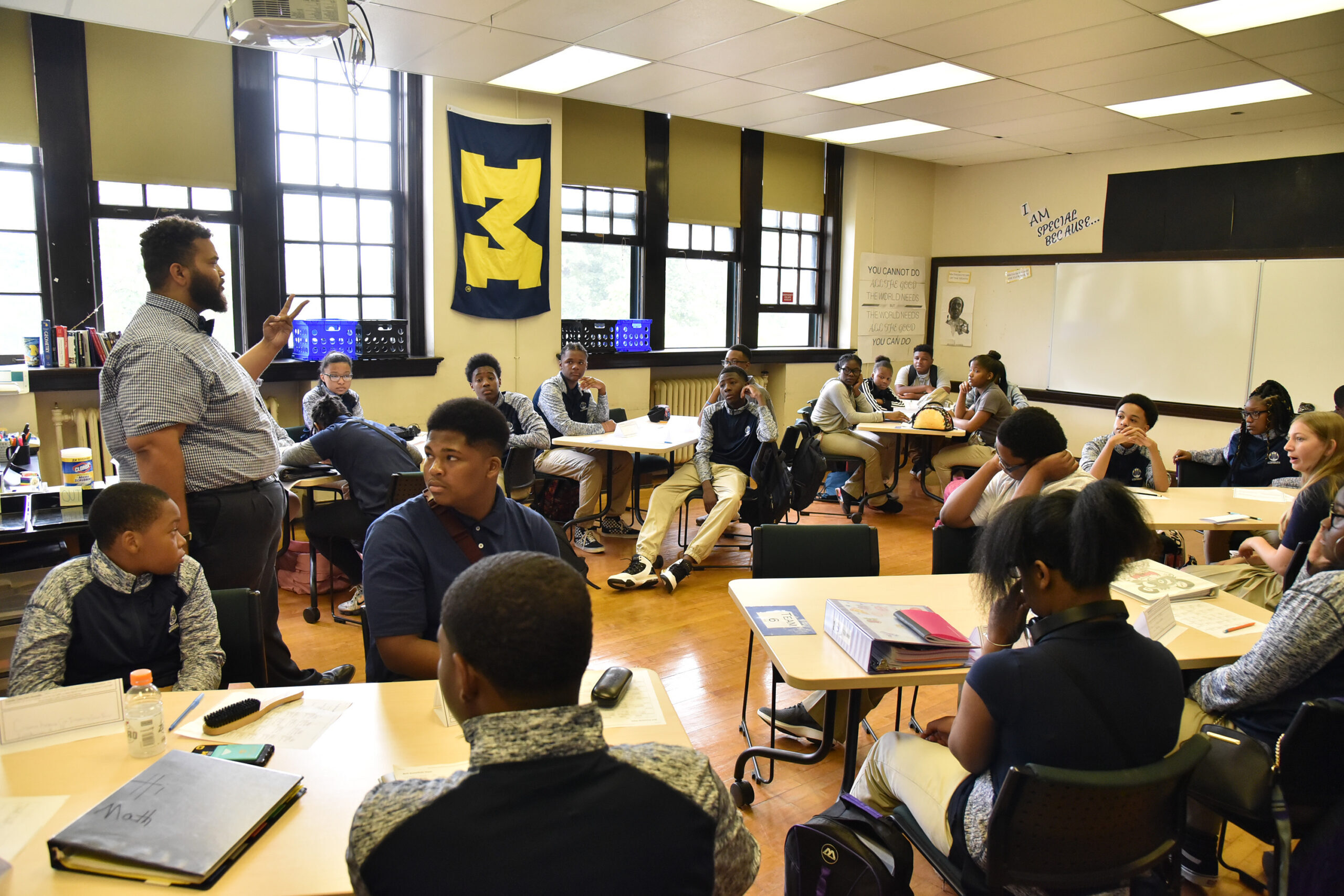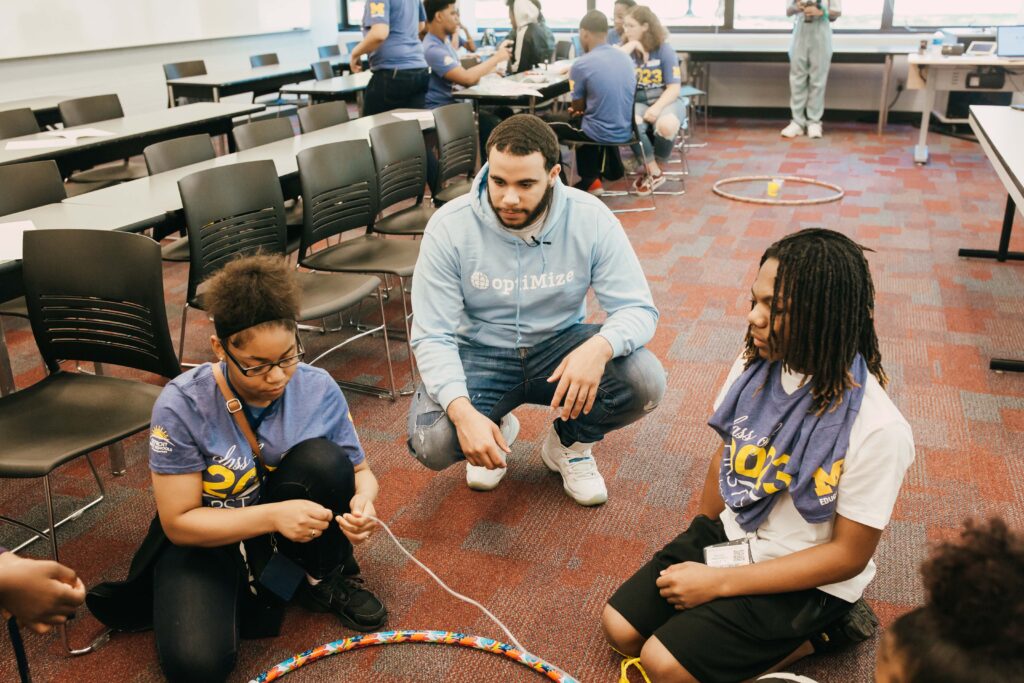
Michael Chrzan (BS ’16) teaches mathematics at The School at Marygrove Photo credit: Peter Smith
Discussions around the fall return to in-person school after more than a year of remote learning largely focused on the general impact on K-12 children and veteran teachers. But little had been said about new first-time teachers whose critical year of classroom-based training was spent learning how to teach on a computer.
Isra Elshafei, a teacher at the School at Marygrove in Detroit, is grateful for a unique teaching residency program that offers additional support and mentoring she doubts others who completed student teaching online during the pandemic are getting.
“As a first-year teacher, I already have felt the craziness of finally being in an actual classroom,” she said. “I feel like that is quickly mitigated just by having that connection. Being able to have support, knowing it will be there, is really helpful, especially knowing burnout rates for teachers within their first three years.”
Elshafei is one of the two newest residents at the School at Marygrove, where the U-M School of Education has a teacher training program that begins with participants enrolled as undergraduate or graduate student interns for one to two years and then continues after graduation and certification throughout their first three years as a public school teacher.
The rigorous teaching residency is structured like a medical school curriculum. Participants enter the program as students earning a bachelor’s or master’s degree with teacher certification. They begin by observing expert teachers at the school and every semester gradually assume more responsibility in the classroom, eventually leading the classroom, from unit planning to daily teaching to assessment and parent meetings.
After graduation, these certified teachers enter the residency that offers the novice teachers mentoring as they grow in the profession. As residents, they are paid Detroit Public School Community District teachers who will move to other city schools after residency.
The Michigan Education Teaching School is the first of its kind, said Elizabeth Birr Moje, dean of the U-M School of Education.
“Although this model of teacher preparation is novel, we hope to demonstrate why it should be the norm,” she said. “We believe that we can solve critical challenges that prevent people from joining or remaining in the teaching workforce by giving educators the support they need to be successful. When we invest in the preparation of educators, we are investing in our communities, economy and democracy.”
The Michigan Education Teaching School and the School at Marygrove are part of a cradle-to-career educational campus formed through a unique collaboration. Partners include U-M, Detroit Public Schools Community District, Kresge Foundation, Starfish Family Services and Marygrove Conservancy.

Photo credit: Heather Nash
The residency pairs new teachers with seasoned professionals—veteran teachers from the district and U-M faculty and staff.
“Our current national model of teacher education is sort of a sink or swim model … you get a couple of years of teacher education coursework and practice, and then you’re on your own. Typically, early career teachers are left to figure things out on their own, and it greatly adds to their stress,” said Darin Stockdill, a mentor who is a curriculum designer at the U-M Center for Education Design, Evaluation, and Research.
“As a mentor, I work collaboratively with the residents to reflect on the challenges they face and identify priorities to work on. Then we implement strategies and ideas and gather data along the way to assess growth and development in teaching practice,” he said. “Some of this is in the moment support, for example, I might quickly suggest a way to adapt an activity to generate more student discussion in the middle of a class I’m observing, or in-between classes. On the other hand, some of the work is more long term and ongoing, particularly with respect to curriculum development and adaptation.”
This year, Stockdill is mentoring Lindsay Helfman, who is teaching history to 11th graders.
Helfman spent 10 years as an adjunct instructor in higher education before going back to earn a Master of Arts with Secondary Teacher Certification at U-M. She laughs at the question many have been asking her: Why go from college teaching to start over with a career in K-12?
One answer is a practical one: Adjunct teaching was too unpredictable. But listen long enough to Helfman talk about her experience, first as an intern and now as a resident, and it’s clear the change is about more than finances and job security.
“These students are amazing. It’s great to see them having fun again,” said Helfman, noting the remote year was hard on the students who had barely started in their new school before the pandemic.
In the history class she teaches, Helfman asks from the first day, “What makes us human? How can we act, locally, to change the world for the better?”
“The teachers start from 9th grade exploring and instilling those values, and the students at Marygrove really embrace them,” she said. “They care about their school, the community and the world.”
Helfman said weekly meetings with Elshafei, 2nd-year resident Katie Guzdial and 3rd-year resident Sneha Rathi prompt discussions about how best to serve their young students.
“It feels like we have our own community,” she said. “It’s really nice to have the support, especially when you are a teacher in an urban district in a totally new career.”
Alistair Bomphray, the P-20 curriculum and teacher education coordinator, said U-M enjoys its collaboration with all at the school as the team seeks to support high quality instruction.
“Well-supported new teachers are better prepared to deliver quality instruction, so our hope is that Marygrove students are engaging in deeper learning experiences because we provide our residents this additional support,” he said. “We are in the process of gathering data to see if this is indeed the case, but early on it certainly looks that way.”
Stockdill said Marygrove students also benefit from exposure to lifelong learning. “
They are able to see their teachers as people working to improve their practice and hopefully gain more appreciation for their hard work,” he said. “The large presence of U-M in the school also gets students talking and thinking about postsecondary education in deeper ways and allows for partnerships and collaborations that might not otherwise happen.”
Prior to becoming a resident, Elshafei worked with a U-M-led team to create the robotics curriculum the school is offering for the first time this year. Like Helfman, she has 11th graders from the first class to start at the high school—100 students across four sections.
“They are all so ready to be back and ready to learn, and just seeing how they take advantage of the opportunities here is incredible,” Elshafei said. “I absolutely love being here, especially being able to teach robotics.”
Written by Laurel Thomas
Contact: Fernanda Pires, fpires@umich.edu


